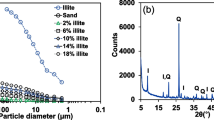Abstract
A surficial clay aquitard extends through the urban area where Mexico City is located. It has been assumed to function as a protective layer to the underlying aquifer that provides 42 m3/s out of 63 m3/s of water used by 18 million inhabitants. To provide such protection, the aquitard must be impermeable to water flow and, ideally, have a significant capacity to sorb contaminants. The latter aspect was addressed, studying the vertical variability of sorption of perchloroethylene (PCE), a widely used organic compound considered to pose health risks in groundwater. Batch sorption tests were used and the clay-rich strata in the depth interval from 8 to 75 m were studied. The results suggest that sorption depends mainly on the fraction of organic carbon (foc) present in the clayey materials. The sorption data were fit to the linear and Freundlich models; many strata could be fit well by either model, while some strata were distinctly non-linear. The linear isotherms showed a mean value of 32.8 ml/g, and the Freundlich isotherm 96.6 ml/g, confirming that the clay-rich media have significant sorption capacity for PCE. From the environmental perspective the clay-rich materials are serving as protection to the groundwater system.
Similar content being viewed by others
Author information
Authors and Affiliations
Additional information
Received: 2 November 1998 · Accepted: 15 February 1999
Rights and permissions
About this article
Cite this article
Mazari-Hiriart, M., Hernández-Eugenio, C., Rojo-Callejas, F. et al. Vertical variability of PCE sorption in the lacustrine clays of Mexico City. Environmental Geology 39, 595–602 (2000). https://doi.org/10.1007/s002540050471
Issue Date:
DOI: https://doi.org/10.1007/s002540050471




